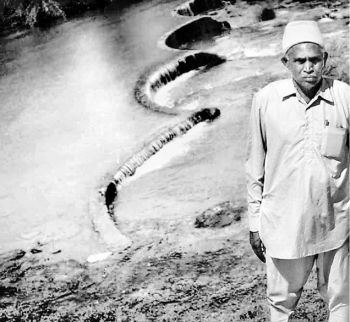THE WELLS of Kalawad village in Junagadh district, Gujarat brim with water. The reason — construction of check dams by a peasant, Mr. Bhanjibhai Mathukiya.Till a few years ago, the drought-prone village forced many of its farmers to abandon agriculture.“Today, most of the wells brim with water and farmers are able to grow their crops without any fear of water shortage, thanks to the three check dams constructed by Mr. Bhanjibhai,” says Mr. Mahesh Patel, Chief Innovation Manager, Gujarat Grassroots Innovations Augmentation Network, (GIAN).

Easy replicability: Bhanjibhai Mathukiya, Gujarat farmer standing in front of his checkdam.
Semi circular arches
The farmer built the first dam across a small river running through the village. It consists of a series of semicircular arches beneath to support the weight (similar to railway bridges to support the weight of a running train). The dam not only costs less than conventional ones, but is also more stable and easy to construct. It resists maximum water pressure and force because of its unique design and structural strength. For constructing the dam the farmer used locally available stones and placed them in the flowing water maintaining a little distance between two stones. Later, he filled the gap with river sand, stones and cement. The total cost for building a dam worked to just Rs.10,000 including the labour cost. After completion of this, several villagers requested Mr. Bhanjibhai to build more check dams down stream.
More dams
So, the farmer built two more dams in the neighbouring villages with the support of a local community. Till date the farmer has built about 25 check dams in Gujarat and Rajasthan.
Explaining the construction of his dam Mr. Bhanjibhai says:
Barriers are constructed at the ends to arrest water overflow through the sides. Overflowing weakens the dam by constant erosion. The conventional dams made by the government in our region are gravity type, deriving their strength in their weight. They are massive and hence require a large quantity of concrete for their construction.To build a dam the expense could work out to anything between Rs. 50,000 to Rs. 1 lakh or more. But I spent only Rs. 10,000 for constructing one dam.As most of the rivers are not perennial, the check dam saves wastage of surplus water from running off. After the monsoon, water shortage makes it difficult to irrigate the crops.
Water table
“The next major source for irrigation is the well. However, with the end of rainfall the underground level of water falls drastically.The check dam prevents water from running off and also recharges the water table,” explains the farmer. Presently the conventional dams in Gujarat are being constructed by the government with the help of the local farmers under the 40-60 schemes — 60 per cent of the cost of construction is borne by the government, with the farmers meeting the remaining 40 per cent. Mr. Bhanjibhai's check dam model can be constructed easily by individuals or co-operative work without waiting for the government's help.
Natural scientists
In devising simple, low cost effective solutions for everyday problems, our country's rural innovators are simply backyard Edisons.With a plethora of new ideas, technologies and innovations, these natural scientists are creating a strong impact in our villages which if properly recognized can play an important role in shaping the world's economy.
“It would be great if the technology could be replicated on mass scale all over India and other countries for the benefit of rural agriculture,” says Mr. Mahesh Patel, Chief Innovation Manager, (GIAN) Gujarat Grassroots Innovations Augmentation Network.
For more information readers can contact
Mr. Bhanjibhai Mathukiya, Kalawad, Junagadh: 362130, Gujarat,
Mobile: 9825481528 and
Mr. Mahesh Patel, Chief Innovation Manager
Phones : 079-26760398 and 26769686.
Email: mahesh@gian.org and gian@gian.org,
website: www.gian.org,